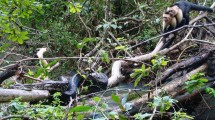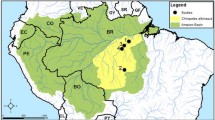Abstract
While some primates attempt to avoid predation by fleeing or hiding, others actually approach, harass, and sometimes attack potential predators, a behavior known as mobbing. Mobbing seems to invite obvious risks, but predators have rarely been observed to injure or kill animals that harass them. The true costs of predator mobbing and the functional significance of this behavior remain poorly understood. Here, we report a fatal attack by a jaguar (Panthera onca) on a mobbing capuchin (Cebus capucinus) that we observed on Barro Colorado Island, Panama. This rare observation illustrates that mobbing predators such as large felids can, indeed, be costly. However, to understand fully the costs of mobbing, the energetic and opportunity costs that primates incur when they harass predators must also be considered.

Similar content being viewed by others
References
Aliaga-Rossel, E., Moreno, R. S., Kays, R. W., & Giacalone, J. (2006). Ocelot (Leopardus pardalis) predation on agouti (Dasyprocta punctata). Biotropica, 38(5), 691–694.
Bartecki, U., & Heymann, E. (1987). Field observations of snake mobbing in a group of saddleback tamarins, Saguinus fuscicollis nigrifrons. Folia Primatologica, 48, 199–202.
Boesch, C. (1991). The effects of leopard predation on grouping patterns in forest chimpanzees. Behaviour, 117(3–4), 220–242.
Caro, T. (2005). Mobbing and group defense. In Anti-predator defenses in birds and mammals (pp. 381–411). Chicago: University of Chicago Press.
Chapman, C. A. (1986). Boa constrictor predation and group response in white-faced Cebus monkeys. Biotropica, 18(2), 171–172.
Cheney, D. L., & Wrangham, R. W. (1987). Predation. In B. Smuts, D. Cheney, R. Seyfarth, R. W. Wrangham, & T. T. Struhsaker (Eds.), Primate societies (pp. 227–239). Chicago: University of Chicago Press.
Correa, H. K. M., & Coutinho, P. E. G. (1997). Fatal attack of a pit viper, Bothrops jararaca, on an infant buffy-tufted ear marmoset (Callithrix aurita). Primates, 38(2), 215–217.
Cowlishaw, G. (1994) Vulnerability to predation in baboon populations. Behaviour, 131(3–4), 293–304.
Cowlishaw, G. (1995). Behavioural patterns in baboon group encounters: The role of resource competition and male reproductive strategies. Behaviour, 132(1–2), 75–86.
Curio, E. (1978). Adaptive significance of avian mobbing .1. Teleonomic hypotheses and predictions. Zeitschrift für Tierpsychologie–Journal of Comparative Ethology, 48(2), 175–183.
Curio, E., & Regelmann, K. (1985). The behavioral dynamics of great tits (Parus-Major) approaching a predator. Zeitschrift für Tierpsychologie–Journal of Comparative Ethology, 69(1), 3–18.
Digweed, S. M., Fedigan, L. M., & Rendall, D. (2005). Variable specificity in the anti-predator vocalizations and behaviour of the white-faced capuchin, Cebus capucinus. Behaviour, 142, 997–1021.
Dugatkin, L. A., & Godin, J. G. J. (1992). Prey approaching predators – a cost-benefit perspective. Annales Zoologici Fennici, 29(4), 233–252.
Eberle, M., & Kappeler, P. M. (2008). Mutualism, reciprocity, or kin selection? cooperative rescue of a conspecific from a boa in a nocturnal solitary forager the gray mouse lemur. American Journal of Primatology, 70(4), 410–414.
Ferrari, S. F., Pereira, W. L. A., Santos, R. R., & Veiga, L. M. (2004). Fatal attack of a boa constrictor on a bearded saki (Chiropotes satanas utahicki). Folia Primatologica, 75(2), 111–113.
Fichtel, C., Perry, S., & Gros-Louis, J. (2005). Alarm calls of white-faced capuchin monkeys: An acoustic analysis. Animal Behaviour, 70, 165–176.
Gil-da-Costa, R., Palleroni, A., Hauser, M. D., Touchton, J., & Kelley, J. P. (2003). Rapid acquisition of an alarm response by a neotropical primate to a newly introduced avian predator. Proceedings of the Royal Society of London - Series B: Biological Sciences, 270(1515), 605–610.
Graw, B., & Manser, M. B. (2007). The function of mobbing in cooperative meerkats. Animal Behaviour, 74, 507–517.
Gros-Louis, J. J., Perry, S. E., Fichtel, C., Wikberg, E., Gilkenson, H., Wofsy, S., et al. (2008). Vocal repertoire of Cebus capucinus: Acoustic structure, context, and usage. International Journal of Primatology, 29(3), 641–670.
Gursky, S. (2005). Predator mobbing in Tarsius spectrum. International Journal of Primatology, 26(1), 207–221.
Gursky, S. (2006). Function of snake mobbing in spectral tarsiers. American Journal of Physical Anthropology, 129(4), 601–608.
Hart, D. L. (2000). Primates as prey: Ecological, morphological and behavioral relationships between primate species and their predators. Saint Louis: Washington University.
Lloyd, E., Kreeltiyutanont, K., Prabnasuk, J., Grassman, L. I., & Borries, C. (2006). Observation of Phayre's leaf monkeys mobbing a clouded leopard at Phu Khieo Wildlife Sanctuary (Thailand). Mammalia, 70(1–2), 158–159.
Mitchell, B. (1989). Resources, group behavior, and infant development in white-faced capuchin monkeys, Cebus capucinus. Berkeley: University of California.
Moreno, R., & Giacalone, J. (2006). Ecological data obtained from latrines use by ocelots (Leopardus pardalis) on Barro Colorado Island, Panama. Tecnociencia, 8, 7–21.
Oppenheimer, J. R. (1968). Behavior and ecology of the white-faced monkey, Cebus capucinus, on Barro Colorado Island. Urbana-Champaign: University of Illinois.
Ouattara, K., Lemasson, A., & Zuberbuehler, K. (2009). Anti-predator strategies of free-ranging Campbell's monkeys. Behaviour, 146, 1687–1708.
Passamani, M. (1995). Field observation of a group of Geoffroys marmosets mobbing a Margay cat. Folia Primatologica, 64(3), 163–166.
Perry, S., & Manson, J. H. (2008). Manipulative monkeys: The capuchins of Lomas Barbudal. Cambridge: Harvard University Press.
Perry, S., Manson, J. H., Dower, G., & Wikberg, E. (2003). White-faced capuchins cooperate to rescue a groupmate from a Boa constrictor. Folia Primatologica, 74(2), 109–111.
Rahlfs, M., & Fichtel, C. (2010). Anti-predator behaviour in a nocturnal primate, the grey mouse lemur (Microcebus murinus). Ethology, 116(5), 429–439.
Rose, L. M., Perry, S., Panger, M. A., Jack, K., Manson, J. H., Gros-Louis, J., et al. (2003). Interspecific interactions between Cebus capucinus and other species: Data from three Costa Rican sites. International Journal of Primatology, 24(4), 759–796.
Ross, C. (1993). Predator mobbing by an all-Male band of Hanuman langurs (Presbytis-Entellus). Primates, 34(1), 105–107.
Schulke, O. (2001). Social anti-predator behaviour in a nocturnal lemur. Folia Primatologica, 72(6), 332–334.
Seyfarth, R. M., Cheney, D. L., & Marler, P. (1980). Monkey responses to three different alarm calls: Evidence of predator classification and semantic communication. Science, 210, 801–803.
Sih, A., Bell, A. M., Johnson, J. C., & Ziemba, R. E. (2004). Behavioral syndromes: An integrative overview. The Quarterly Review of Biology, 79(3), 241–277.
Touchton, J. M., Hsu, Y.-C., & Palleroni, A. (2002). Foraging ecology of reintroduced captive-bred subadult harpy eagles (Harpia harpyja) on Barro Colorado Island, Panama. Ornitologia Neotropical, 13(4), 365–379.
Wheeler, B. C. (2008). Selfish or altruistic? an analysis of alarm call function in wild capuchin monkeys, Cebus apella nigritus. Animal Behaviour, 76, 1465–1475.
Willis, E. O., & Eisenmann, E. (1979). A revised list of birds of Barro Colorado Island, Panama. Smithsonian Contributions to Zoology, 291(1–31).
Zuberbuhler, K., Noe, R., & Seyfarth, R. M. (1997). Diana monkey long-distance calls: Messages for conspecifics and predators. Animal Behaviour, 53, 589–604.
Acknowledgments
We thank the Autoridad Nacional del Ambiente (ANAM) and the government of the Republic of Panama for permission to conduct this research. We thank the Smithsonian Tropical Research Institute, the Wenner-Gren Foundation for Anthropological Research, Princeton University, and the Max Planck Institute for Ornithology for funding. We also thank the staff of the Barro Colorado Island research station, whose daily help and support was critical to the success of this research. We extend special thanks to Jacalyn Giacalone, Ben Hirsch, Sara Pinzon, Roland Kays, and Oris Acevedo for their helpful comments and suggestions on a previous version of this manuscript. Two anonymous reviewers and Joanna Setchell provided thoughtful and constructive comments and criticisms that we gratefully acknowledge.
Author information
Authors and Affiliations
Corresponding author
Rights and permissions
About this article
Cite this article
Tórrez, L., Robles, N., González, A. et al. Risky Business? Lethal Attack by a Jaguar Sheds Light on the Costs of Predator Mobbing for Capuchins (Cebus capucinus). Int J Primatol 33, 440–446 (2012). https://doi.org/10.1007/s10764-012-9588-1
Received:
Accepted:
Published:
Issue Date:
DOI: https://doi.org/10.1007/s10764-012-9588-1




